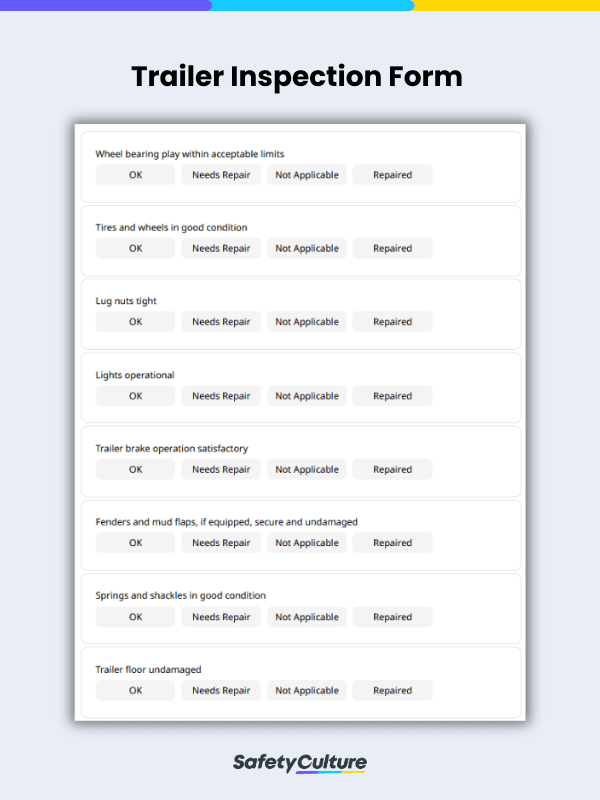What is a Trailer Inspection?
A trailer inspection is the act of conducting a thorough inspection of a trailer to promote road safety and help ensure that it is fit to contain its intended cargo. Also called a truck and trailer inspection, it is conducted not only to prove the roadworthiness of a trailer but also to protect its safety and security against illegal activities such as transportation of contraband.
Completing and documenting trailer inspections are required for all trailers that are going to enter US borders and drivers are expected to be familiar with inspecting trucks and trailers using a trailer inspection form.
What is a Trailer Inspection Form?
Commonly used by truck drivers, a trailer inspection form is a tool used for thoroughly checking the condition of a truck and trailer. Crucial to maintaining the good working condition of trailers, a good trailer inspection form guides the driver on what to check and what to look out for during trailer inspections in compliance with regulations.
How to Conduct the 17-Point Truck and Trailer Inspection
As a requirement of US Customs and Border Protection for trucks and trailers bound to enter US borders, truck drivers can benefit from being familiar with the 17 points to inspect using a truck and trailer inspection form. Here’s a quick guide on the 17 points to check:
- Bumper – Check under the bumper using your flashlight and inspection mirror to ensure that there’s nothing on the underside of the bumper.
- Engine – Make sure that the engine is turned off first before checking the compartments and removing the filter. Make use of a mirror to ensure that all surfaces are inspected.
- Tires (truck and trailer) – Use a tool to vibrate all the tires of the truck and the trailer. Check the spare tire and compartment as well.
- Truck’s Floor – Get into the truck and check the floor. Look under the carpet and ensure that there are no other people.
- Fuel Tanks – Tap the fuel tank and listen for void sound. Use your flashlight and look inside the tank.
- Cab/Storage Compartments – Check and make sure that the storage compartments are locked. Inspect the cab inside and outside.
- Air Tanks – On the truck, tap and listen for void sound. On the trailer, inspect for any weld marks.
- Drive Shafts – Look closely to check for repairs or new paint. Tap and listen for a hollow sound.
- Fifth Wheel – Check empty spaces and the security of the battery area.
- Outside/Undercarriage – Use your mirror to check the inside lip. Inspect the area of the rear lights.
- Outside/Inside Doors – Check the locking mechanism and ensure that the bolts, rivets, and door hinges are secure. Look closely and observe if there are any weld marks or repairs.
- Trailer Floor – Look inside the trailer and check if the floor is flat and not lifted. Make sure that the planks are bolted down.
- Side Walls – Check the side walls for any indication of new or loose panels. If there is a loose panel, use your flashlight and take a look inside.
- Front Wall – Check if the front wall panels are secure and look closely for any signs of repair. Measure the length to ensure that there is no false wall.
- Ceiling/Roof – Measure the height from floor to ceiling make sure that there is no false roof. On the roof, check for new rivets and any signs of repair.
- Refrigeration Unit (if any) – Turn off the refrigeration unit before you open the doors to look inside using your flashlight.
- Exhaust – Be careful as the exhaust might be hot during the inspection. Look for taped packages and make sure that the exhaust is not loose.
Challenge of Using Paper-based Inspection Forms
Using paper-based trailer inspection forms have inherent disadvantages. They can get damaged, hand written notes can be difficult to read, and worse is that they can get lost when one of the reasons they are used in the first place is to have a guide and documentation for the trailer inspection. Using a digital inspection tool that is readily available and easy to use can solve these issues and more.


